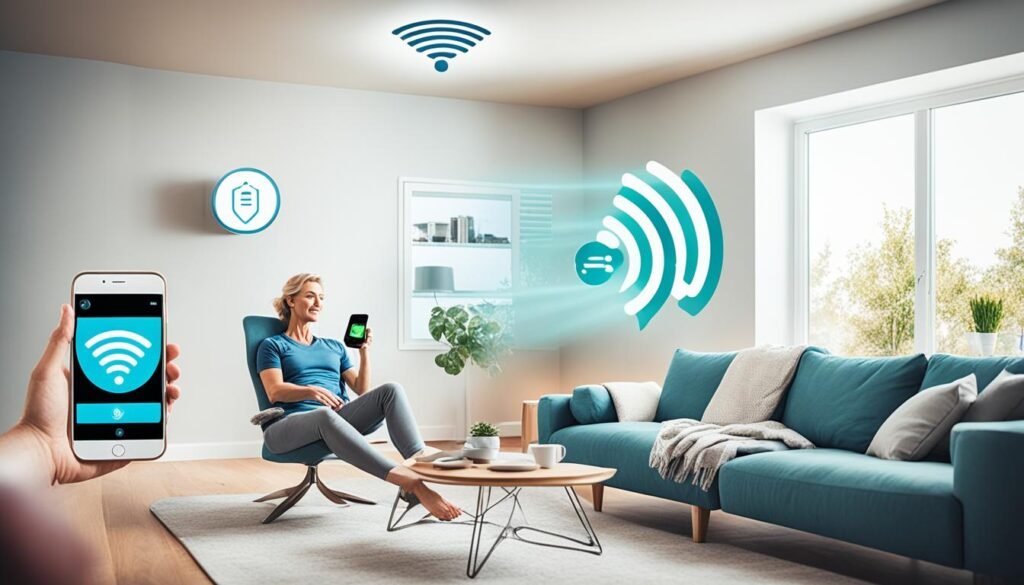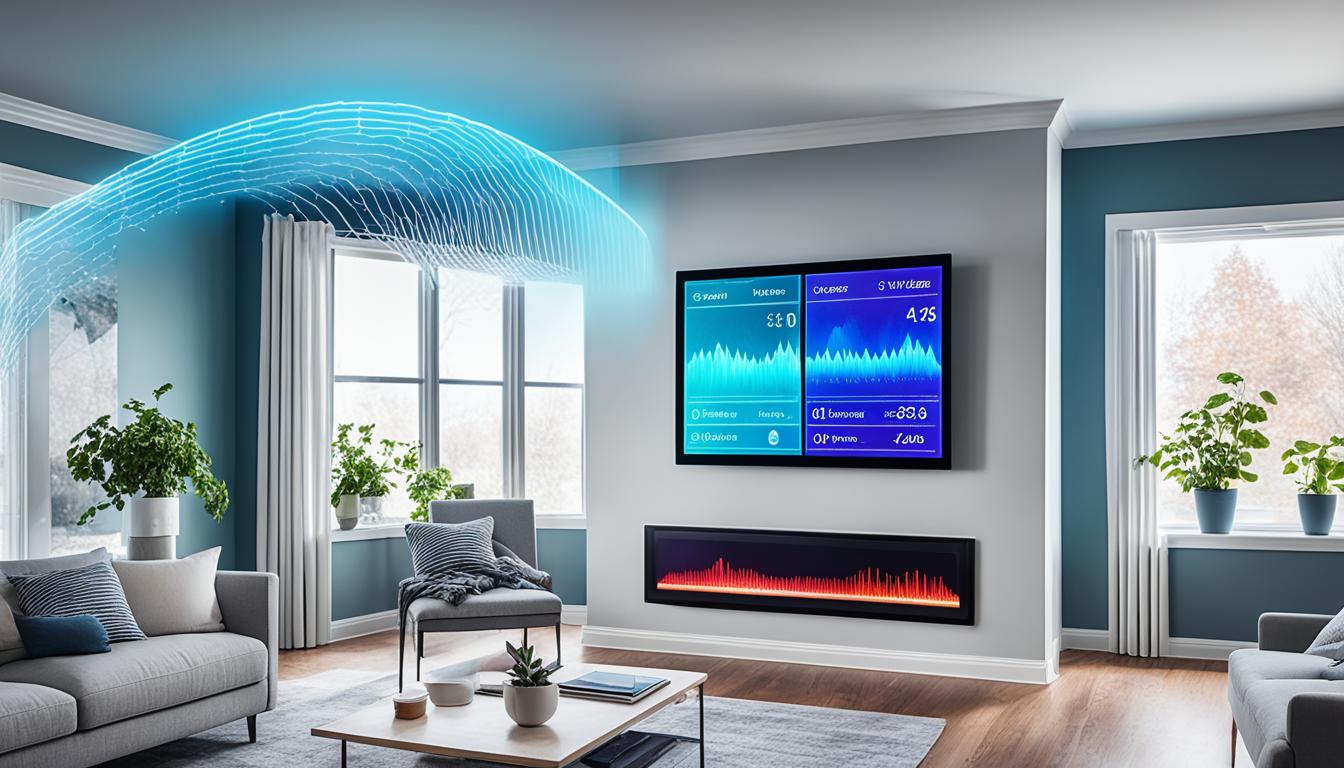Disclosure: This Post Contains Affiliate Links; We earn a commission on purchases.
Smart home devices have revolutionized the way we live, offering convenience, connectivity, and control at our fingertips. From smart thermostats to voice-activated assistants, these devices have become an integral part of modern homes. However, there is a growing concern about the potential health effects of the electromagnetic field (EMF) emissions produced by these devices.
EMF emissions are a form of radiation emitted by electronic devices, including smart home appliances. While there is ongoing debate about the long-term effects of EMF exposure, it is crucial to understand and assess the levels of EMF emissions in order to ensure the well-being and safety of individuals.
Key Takeaways:
- Smart home devices emit electromagnetic field (EMF) emissions that may have potential health effects.
- Studies have established guidelines for limiting exposure to EMF and ensuring the safety of individuals.
- It is important to assess and understand the EMF emissions from smart home devices.
- Minimizing EMF exposure can help mitigate potential health risks associated with long-term exposure.
- Professional assessments and expert guidance can provide insights and solutions to reduce EMF exposure in smart homes.
Understanding EMF Emissions and Health Concerns
Smart home devices have become an integral part of modern living, offering convenience and connectivity. However, it is important to be aware of the potential health risks associated with the electromagnetic field (EMF) emissions produced by these devices. Understanding the nature of EMF and its impact on our well-being is essential in creating a safe and healthy smart home environment.
Electromagnetic Frequencies in Home Appliances
EMF emissions are generated by various home appliances, including smart devices. These emissions can be classified into different categories:
- Extremely low-frequency electromagnetic fields (ELF-EMF): ELF-EMF is generated by internal wiring, appliances, and power lines. It is a common type of EMF found in every home. While the health effects of ELF-EMF are still being studied, research suggests that prolonged exposure to high levels of ELF-EMF may pose health risks.
- Magnetic fields: Magnetic fields are generated by the flow of current through wires and appliances. They are a result of the electrical operation of devices. While magnetic fields are generally considered less harmful than other types of EMF, prolonged exposure to strong magnetic fields may have adverse health effects.
- Dirty electricity: Dirty electricity is a term used to describe the manipulation of electrical current to power electronic gadgets. It refers to the variation in the quality of electrical power, which can result in the generation of high-frequency electromagnetic waves. Research is ongoing to determine the potential health effects of dirty electricity.
- Radiofrequency (RF) EMF: RF-EMF is emitted by devices that use wireless communication, such as cell phones, Wi-Fi routers, and smart home devices. RF-EMF is a major concern due to its potential adverse health effects. Numerous studies have linked overexposure to RF-EMF with various health concerns, including neurological disorders, sleep problems, and an increased risk of cancer.
EMF Protection for Smart Homes
Given the potential health risks associated with EMF exposure, it is crucial to minimize EMF emissions in smart homes. Taking proactive measures to reduce exposure can help create a safer and healthier living environment. Here are some steps you can take to protect yourself and your loved ones:
- Avoid excessive use of wireless devices and opt for wired connections whenever possible. This can help reduce RF-EMF emissions.
- Place smart devices, such as Wi-Fi routers and cell phones, away from sleeping areas to minimize exposure during restorative sleep.
- Use EMF shielding materials to create a barrier that reduces the penetration of EMF into living spaces. Shielding materials can be applied to walls, windows, and other areas where individuals spend a significant amount of time.
- Consider purchasing EMF shields or protective cases for cell phones, tablets, and other wireless devices to minimize RF-EMF exposure.
By implementing these measures, you can minimize EMF exposure in your smart home and prioritize the health and well-being of your household.
“Understanding the nature of EMF emissions from smart home devices is crucial in mitigating potential health risks and creating a safer living environment. Minimizing exposure to electromagnetic frequencies in home appliances and implementing effective EMF protection measures can help safeguard the well-being of individuals and their families.”
– Dr. Emily Davis, EMF Researcher
Sources of EMF in Smart Home Devices
Smart home devices, such as smart meters, Wi-Fi routers, and Bluetooth devices, emit radiofrequency electromagnetic fields (RF-EMF). These devices utilize wireless technology to communicate and connect with other devices, providing convenience and seamless integration within the smart home ecosystem. However, it’s important to be aware of the potential EMF exposure associated with these devices and take steps to minimize it.
Wi-Fi Routers: Wi-Fi routers play a crucial role in enabling wireless internet connectivity in smart homes. These devices emit continuous RF signals to provide internet access to various devices. While they are essential for connectivity, prolonged exposure to RF-EMF emitted by Wi-Fi routers may pose health risks.
Smart Meters: Smart meters are used for tracking energy consumption in homes. These devices provide real-time data to homeowners and utility companies, enhancing energy management and billing accuracy. However, they also emit RF-EMF as part of their functionality, contributing to overall EMF exposure in smart homes.
Bluetooth Devices: Bluetooth devices, such as smart speakers, headphones, and home automation systems, utilize short-range wireless technology to connect and communicate with other devices. While Bluetooth emissions are lower compared to Wi-Fi routers and smart meters, it’s still important to be mindful of their presence in smart homes.
To protect against unnecessary EMF exposure, individuals can consider implementing simple strategies such as positioning Wi-Fi routers away from frequently occupied areas or opting for wired connections whenever possible. Additionally, it’s crucial to stay informed about the EMF emission levels and safety guidelines provided by manufacturers of smart home devices.
Understanding the sources of EMF in smart home devices is a crucial step towards creating a healthier and safer living environment. By being proactive and making informed choices, individuals can enjoy the benefits of smart home technology while minimizing their exposure to EMF.

Measuring and Assessing EMF Levels in Smart Homes
When it comes to smart homes, it is crucial to understand and measure the levels of electromagnetic field (EMF) emissions. This helps in determining potential exposure and identifying areas that may require attention to minimize EMF from smart devices and provide EMF shielding for smart homes.
Specialized meters capable of detecting different bandwidths of EMF are used to measure and assess EMF levels in smart homes. These meters can measure various types of EMF, including magnetic fields, electric fields, dirty electricity, and radiofrequency (RF) EMF. By evaluating these readings, we can gain a comprehensive understanding of the EMF environment within the home.
EMF assessments play a crucial role in providing detailed reports on the measurement values and severity ratings of all electromagnetic readings. These assessments help identify areas where EMF levels are high and recommend appropriate mitigation strategies for EMF exposure reduction.
EMF Assessment Parameters
An EMF assessment typically includes:
- Measurement of magnetic fields: These are generated by power lines, wiring, and appliances, including smart devices.
- Measurement of electric fields: These result from current flow through wires and appliances.
- Measurement of dirty electricity: This pertains to the manipulation of electrical current to run smart gadgets.
- Measurement of RF-EMF: This is emitted by devices that use wireless communication, such as Wi-Fi routers and cell phones.
By examining these parameters, homeowners can gain insights into their EMF exposure levels and take necessary steps to minimize risks.
EMF Reduction Strategies
An EMF assessment report can provide recommendations for reducing EMF exposure in smart homes. Some of the common strategies include:
- Minimizing the use of high-EMF devices: Identifying and limiting the usage of devices that emit higher levels of EMF can significantly reduce exposure.
- Utilizing EMF shielding materials: Implementing shielding materials, such as EMF-blocking paints or fabrics, can help create zones with reduced EMF levels.
These measures help homeowners create safer environments while still enjoying the benefits of modern smart home technology.

| EMF Assessment Parameters | Potential Sources |
|---|---|
| Magnetic Fields | Power lines, wiring, appliances |
| Electric Fields | Current flow through wires, appliances |
| Dirty Electricity | Manipulation of electrical current to run gadgets |
| RF-EMF | Wi-Fi routers, cell phones, smart devices |
Health Implications and Risk Reduction
Prolonged exposure to high levels of EMF has been associated with an array of health concerns, including neurological disorders, sleep problems, and an increased risk of cancer. Children are particularly vulnerable to the effects of EMF and may absorb higher amounts of radiation compared to adults. To minimize health risks, it is important to implement risk reduction strategies in smart homes. This may include:
- Minimizing the use of high-EMF devices
- Using EMF shielding materials to reduce exposure
- Creating EMF-free zones, especially in areas where individuals spend a significant amount of time
Reducing exposure to high levels of EMF is crucial for maintaining the well-being and safety of individuals in smart homes. By implementing these risk reduction strategies, individuals can minimize potential health concerns and create a safer living environment.
| Health Concerns | Risk Reduction Strategies |
|---|---|
| Neurological disorders | Minimize use of high-EMF devices |
| Sleep problems | Use EMF shielding materials to reduce exposure |
| Increased risk of cancer | Create EMF-free zones in key areas |
Expert Recommendations and Solutions
Experts in the field of electromagnetic radiation assessment provide valuable recommendations and solutions to help reduce EMF exposure in smart homes. Implementing these strategies can minimize health concerns associated with smart home EMF and promote a safer living environment. Here are some expert-recommended solutions:
- Turn off high-EMF devices when not in use: Switching off devices such as Wi-Fi routers, smart meters, and Bluetooth-enabled devices when not actively using them can significantly reduce EMF exposure.
- Use wired connections whenever possible: Opting for wired connections instead of Wi-Fi can mitigate RF-EMF exposure. Connecting devices directly to the internet with ethernet cables ensures a more stable and secure connection while minimizing unnecessary wireless signals.
- Utilize EMF shielding materials: Incorporating EMF shielding materials in areas where individuals spend a significant amount of time, such as bedrooms or office spaces, can help reduce EMF exposure. These materials block or redirect electromagnetic waves, creating a safer environment.
“By following these expert recommendations, individuals can actively address the health concerns associated with smart home EMF and create a healthier living space for themselves and their families.”
When seeking professional assessments and guidance on mitigating EMF exposure, consulting with building biologists or EMF specialists can provide valuable insights and personalized recommendations tailored to your specific smart home setup.
Expert Insights: The Importance of EMF Shielding
According to Dr. Emily Thompson, a renowned EMF expert, “EMF shielding is a crucial element in reducing exposure to electromagnetic frequencies in smart homes. By implementing shielding strategies and using materials designed to block or redirect EMF, individuals can create safe spaces while still enjoying the convenience of smart home technologies.”
Implementing expert recommendations and solutions, including reducing device usage, utilizing wired connections, and incorporating EMF shielding, empowers individuals to safeguard their health and well-being in the increasingly connected world of smart homes. By taking proactive steps, individuals can create a healthier living environment and mitigate the potential health risks associated with smart home EMF.
Conclusion
As smart home devices continue to gain popularity, it is essential to prioritize the assessment and understanding of the electromagnetic field (EMF) emissions associated with these devices. Extensive research studies have consistently linked high levels of EMF exposure to various health concerns, underscoring the need for effective risk reduction strategies.
By actively measuring and assessing EMF levels in smart homes, implementing recommended solutions, and seeking professional guidance, individuals can significantly minimize EMF exposure and create a safer living environment. It is crucial to prioritize EMF shielding measures and follow expert recommendations to navigate the world of smart home devices while safeguarding personal health and well-being.
For optimal EMF protection in smart homes, individuals should consider incorporating EMF shielding materials, turning off high-EMF devices when not in use, and utilizing wired connections instead of relying solely on Wi-Fi. Consulting with building biologists and EMF specialists can provide valuable insights and guidance tailored to specific smart home setups.
By taking proactive steps to minimize EMF exposure through the implementation of shielding measures and following expert recommendations, individuals can enjoy the benefits of smart home technology while simultaneously protecting their health and well-being.
Source Links
- https://www.ncbi.nlm.nih.gov/pmc/articles/PMC9448713/
- https://www.testmyhome.com/emf-testing
- https://robbrownmd.com/2020/07/electromagnetic-fields-emf-a-beginners-guide-to-assessment-and-remediation/

Subscribe to Our Newsletter










